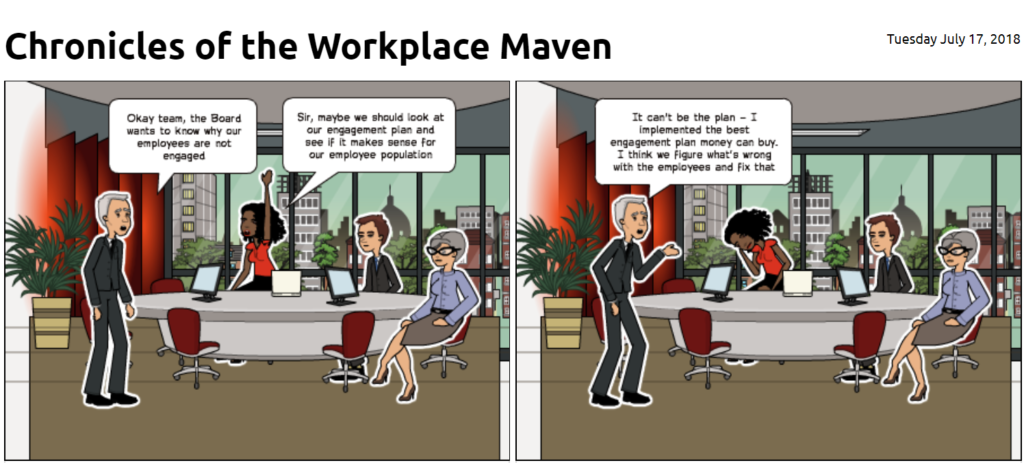Employee engagement occurs when an employee feels an emotional connection to an organization and its goals, such that they are wholeheartedly invested in that organization’s work. Studies have consistently found that high levels of engagement are significant contributors to an organization’s success. As such, having a successful engagement strategy is essential to moving any business forward. Below are 4 steps to building an effective employee engagement strategy.
1. Understand Your Current Engagement Levels
For better or for worst, understanding your existing level of employee engagement is where you need to begin. As the saying goes – you can’t know where you’re going until you know where you’ve been. You can gain a current understanding of the current state of employee engagement within your organization in several ways. For instance, a proactive approach can involve having forthcoming town hall sessions; conducting employee surveys; or incorporating pointed questions into your performance management process. You can also take a responsive approach such as conducting exit interviews to understand whether there are issues in the workplace environment that are impacting your engagement or examine recent challenges that may exist such as workplace litigation, administrative intervention or union organizing. Whether you choose one approach or a combination thereof, the key is to ask the right questions to gain more transparency and understand what the true state of your engagement is with your workforce.
2. Listen & Learn
Ask employees what they would like to see – what do they see lacking. You can spend thousands of dollars implementing an engagement program that has all the bells and whistles, in fact companies are currently spending more than $720 million per year on employee engagement, but, if your engagement strategy doesn’t touch or connect with your particular employee population it will have been wasted money and effort. So where do you begin? You can start by gaining an understanding of your employee demographics (by function, age, geography, education, tenure, attitudes, etc.) and learning what is important to them. A word of caution however, don’t make the mistake of assuming that the most important factor in employee satisfaction will be compensation. In fact, Glassdoor Economic Research has found that across all income levels, the top predictor of workplace satisfaction is not pay. While it is a factor, it is not the leading factor that produces engagement. So, look beyond the money – what are the aspects of work that are either their biggest pain points or their biggest recompense. Perhaps you have a large segment of your population that values work-life balance where creating greater workplace flexibility would be greatly appreciated. Or you have individuals that crave being a part of something greater than themselves where an organization that engages in charitable efforts would help them with fulfilling that sense of purpose. A workplace culture that is aligned with the needs and values of its employees and vice versa will consequently encourage higher levels of engagement.
3. Document a Plan & Make it Plain
Once you’ve determined what are the types of initiatives and/or efforts that would positively impact engagement, documenting and communicating the plan is essential to success. You must be able to visualize what you need to achieve and how you’re going to get there – but more importantly, communicate that vision to the relevant stakeholders so that they can buy into the vision. One helpful approach is to use the goal setting acronym SMART which in this case stands for Specific, Measurable, Assignable, Realistic, and Time-bound. First, be specific – lay out what are the specific target areas your strategy will seek to address and explain why you will be focusing on those areas. The more specific you are, the easier it is to know what actions will lead you to it. Next, measure – explain what you hope to accomplish from this endeavor and what will be the measures of success. Assign – specify who will be responsible for which actions in executing the strategy. Then, be realistic – state what are the realistic results you hope to achieve bearing in mind any restraints you may be dealing with, i.e. available resources, budget, time, etc. Finally, ensure you are spelling out time related milestones that specify when the different steps should be taken, and respective results achieved. In sum, the more transparent the entire engagement plan and the more clearly you set expectations about the plan, the more likelihood you will attain buy-in and build the trust and engagement you are seeking.
4. Implement – Make it Happen
Now it’s time to bring the strategy to life and make it happen. Implementing your engagement strategic plan is as important, or even more important, than the plan itself. So many well-intentioned strategies die on the vine because the plans become nothing more than a document that sits on a shelf. Critical to implementation is determining the Who, When and the How. Essentially, take your strategic plan and identify who will be responsible for each aspect of the plan. Track when the milestones you’ve identified should be taking place and ensure you’ve incorporated a method of accountability. Lastly, how will the tasks be accomplished – whether it be contracting external resources, purchasing necessary equipment, or creating an internal project team – understanding what is necessary to accomplish the goals is pivotal to proper implementation. And then get it done!
Following these 4 critical steps will move an engagement strategic plan from great intentions to actions that drive true employee engagement. If your organization needs help understanding its level of employee engagement or creating a responsive employee engagement plan please contact info@hrandbeyond.com – we’d be glad to help.

